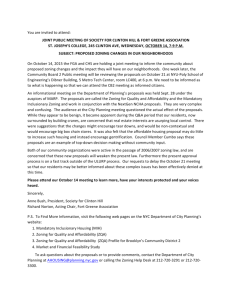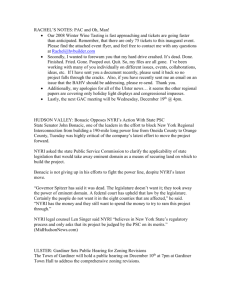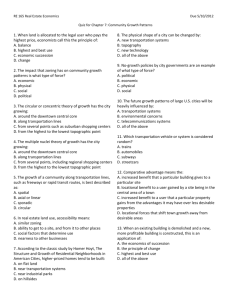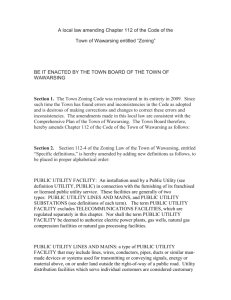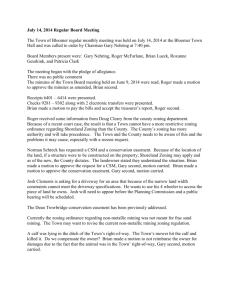Master+Planning+&+Building+&+Dev+Control
advertisement
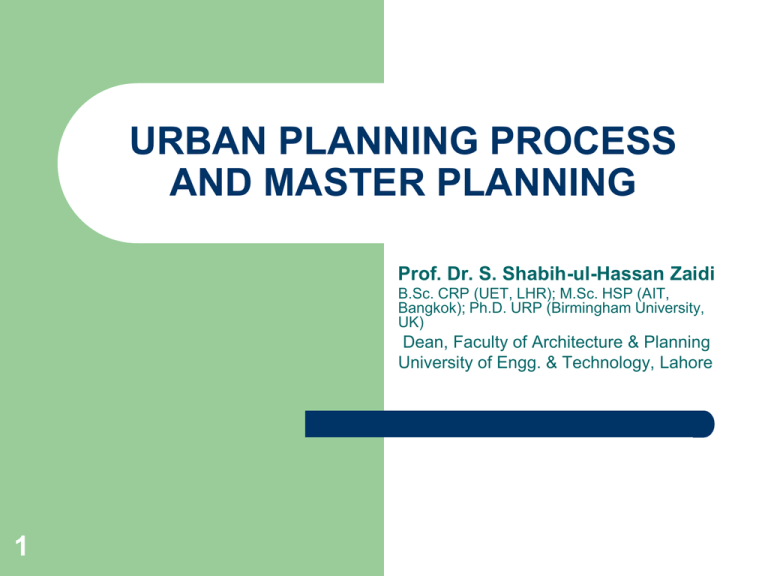
URBAN PLANNING PROCESS AND MASTER PLANNING Prof. Dr. S. Shabih-ul-Hassan Zaidi B.Sc. CRP (UET, LHR); M.Sc. HSP (AIT, Bangkok); Ph.D. URP (Birmingham University, UK) Dean, Faculty of Architecture & Planning University of Engg. & Technology, Lahore 1 The need for Urban Planning It is by now considered as an established principle that some control of land use is required to be applied by the public authorities to safeguard people from the atrocities of the unwanted uses. For example the industrial use may create noise, odour, smoke, dust, and gases harmful to the human health. It is, therefore, necessary to separate such noxious uses from the living areas. We cannot leave our cities to the mercies of the market mechanism and leave people to suffer at the hands of profiteers. 2 PLANNED VS UNPLANNED GROWTH OF CITIES 3 The unplanned growth of cities is characterized by the haphazard development of mixed uses, in the form of slums and squatter settlements which suffer from the lack of utility services, public facilities and open space. The planned growth of cities is characterized by proper placement of all land uses and provision of utility services and public facilities in a planned manner in the form of housing schemes and planned shopping centers, industrial estates and parks & open spaces. URBAN PLANNING AND DEVELOPMENT PROCESS Goals & Objectives Surveys & Data Collection Evaluation & Feedback Problem Identification Implementation Of Plans & Projects Planning & Designing 4 Policies & Strategies Land Use Zoning Land Use Zoning means the spatial distribution of city functions- its residential areas, its industrial, commercial and retail business districts and the spaces set aside for institutional and leisure-time functions in a proper manner. In a Land Use Zoning Plan, separate zones (sub-areas) are allocated for different uses in such a manner that incompatible uses are separated from each other. 5 Master Planning A Master Plan is defined as a comprehensive plan which provides guidelines for the future development of a city, town or district. It is an important document which lays foundation for securing a better environment and as a result better quality of life. It mainly provides policies regarding the land use development and control while targeting at: 6 i) Improving quality of life by enhancing built and natural environment. ii) Encouraging coordinated economic development and spreading its benefits. iii) Making the most effective use of infrastructure. FORM OF THE MASTER PLAN The Master Plan is composed of: 1) A Proposals Map: It is basically a proposed Land Use Zoning Plan and Layout Plan of Roads and other means of transportation. 2) Written Statement/ Document: It is a document containing a summary of existing conditions, policies and strategies, interpretation of land use zoning and layout plans and other proposals for various subjects of the plan such as Utility Services, Public Facilities, housing, transportation, income and employment and other socio-economic aspects. 7 Salient Features of the Modern Master Plan 8 Surveys and Data collection about all aspects of the physical, social and economic life of the area (City or Tehsil). For example, Land Use, Socioeconomic, Housing, Industrial Commercial and Transportation surveys and survey of schools, hospitals and other public buildings. Use of Computers and GIS technology for the creation of a data base and the preparation of Master Plan. Involvement of Local people, stakeholders and local administration in the preparation and implementation of Master Plan. Special concern about the Environmental Protection and conservation of resources. Implementation procedures for the execution of proposed projects must be contained within the Master Plan document. FUNCTIONS OF THE MASTER PLAN 9 Interpreting national and regional policies. Establishing aims, policies and general proposals. Providing framework for local plans. Indicating action areas. Providing guidance for development control. Providing basis for coordinating decisions. Bringing before the Council and the public the main Planning issues and decisions. Local Plans as Component Plans of the Master Plan The Master Plans, Spatial Plans, Structure Plans and Development Plans prepared these days are a set of an overall general plan and a number of local plans such as: i) Local district plans, for comprehensive planning of relatively extensive areas. These are middle order plans which serve as a link between Master Plan and the Local Action Area Plans or site development schemes. ii) Local action area plans, for comprehensive planning of areas selected for intensive change which is to commence within a specified period. These are detailed plans which go up to plot sub-division level. In fact these are site development schemes and existing slum improvement schemes, ready for implementation on ground. 10 Local Plans as Component Plans of the Master Plan ….Contd. iii) 11 Subject plans, for the detailed treatment of a particular planning aspect in part or all of Master Plan area. These plans are needed for certain aspects of planning which need special emphasis for a part or entire city area. The Local Plans provide guidance for new developments as well as improvement of existing areas and in actual practice the local plans of the lowest order are implemented on ground in the form of projects. THE NEED FOR A MIDDLE ORDER LOCAL PLAN The Local District Plans or Middle Order Plans are required to be prepared because: 1. 2. 12 3. The Local Action Area Plans or Site Development Schemes must be prepared under the guidelines provided by the Local District Plans. The Master Plans provide over-all policy guidelines only. The mosaic of a number of small local schemes becomes a large area requiring higher order physical and social infrastructure such as Trunk Sewers, Hospitals and Colleges. These higher order utility services and public facilities can only be provided through a Middle Order Plan. Major road layout pattern and provision of large CBDs can only be ensured through a Middle Order Plan. Form Of The Local Plans The Local Plans are composed of: 1) A Proposals Map or Illustrative diagrams: These are detailed maps/ plans and illustrative diagrams showing details of the all the proposals to be implemented. 13 2) Written Statement/ Document: It is a document containing a summary of existing conditions, policies and strategies, interpretation of the detailed proposals to be implemented in the local area, and the procedures for implementation of the local plan. Functions of Local Plans 14 Applying the strategy of the Master Plan in detail. Providing detailed basis for development control. Providing basis for coordinating decisions. Bringing before the public detailed planning issues and decisions. DEVELOPMENT DEFINED The word development is defined as ‘the carrying out of building, engineering, mining or other operations in, on, over or under land, or making of any material change in the use of buildings or other land’. (Cullingworth, 1982, p.78). 15 TOWN PLANNING AND THE BUILDING AND DEVELOPMENT CONTROL 16 John Stephenson (1982, p.7) defines Town Planning as, ‘Planning falls broadly into two categories. First, development planning is the part of the process in which the future of the area in question is mapped out. The plans will be concerned not only with building but also with job opportunities, manpower, education, and transport. Secondly, development control ensures that the construction of buildings, and the use to which land and buildings are put conforms to established policies’. APPLICATION OF BUILDING AND DEVELOPMENT CONTROL 17 Land Use Control can be ensured through the development of a Land Use Zoning Plan and the application of an effective building control and development control system to implement the Master Plan. Generally speaking all developments should require planning permission which can be obtained from local planning authority such as TMAs under the present local government system in Pakistan. This requires the application of Building Control Bylaws and Scheme Approval Regulations. The TO (P&C) has to carry out this assignment in a TMA. In the development authorities the Town Planning wing does this job. Implementation of Plans through Building and Development Control 18 Development control is the cutting edge of the land use planning system. It is the mechanism by which planning affects most people and a Master Plan (which is prepared in consultation with the concerned people and is approved by a people’s representative body) gets implemented. Development control necessarily involves some procedure for enforcement. This is provided by ‘enforcement notices’ under which an owner who carries out development with out permission or in breach of conditions can be compelled to undo development—even if this involves the demolition of a new building. Building Byelaws and Development Control Regulations 19 Building and Development Control is implemented through certain laws or byelaws such as: 1) Zoning and Land Sub-division Regulations as in USA or Town and Country Planning Act, 1971 of U.K. (Comprehensive Town Planning Laws). 2) Building Byelaws of LDA, Lahore. (Byelaws prepared by local development authorities or TMAs). 3) Punjab Private Site Development Schemes (Regulation) Rules, 2005. (Provincial level Rules and Regulations).
